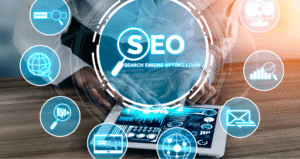Is AI the Future of Digital Marketing Superpower We Always Wanted — or a Problem in Disguise?

You ever get that feeling that your phone knows what you’re thinking? Like, you talk about dog beds once and suddenly every ad in your feed is about orthopedic memory foam for your Labradoodle?
Yep. Been there.
Welcome to the wild, sometimes creepy, always fascinating world of digital marketing and AI
It’s moving fast. Like, “blink and there’s a new tool” fast. And while it’s undeniably exciting (hello, hyper-personalized everything), it’s also raising some eyebrows — and not just the skeptical kind. We’re talking real questions around privacy, ethics, and where the human touch fits into all this fancy automation.
So today, let’s have a real convo about the good, the bad, and the “hmmm…” of AI in marketing — and how we, as marketers, entrepreneurs, or just curious humans, can navigate this crazy digital shift without losing our soul in the process.

So… What Even Is Happening Right Now?
Okay, deep breath.
AI is here. Not in some sci-fi, “robots running the show” kind of way, but in ways that actually affect how we shop, sell, and connect.
You’ve probably interacted with AI today without even noticing. That chatbot that solved your issue at 2 a.m.? AI. The Netflix row that magically knows you’re into true crime with a side of comedy? AI. The email subject line that lowkey made you click because it felt personal? Yep — that too.
Basically, it’s like we’ve given marketing this superpower. But we also need to be smart about how we use it.
Let’s Talk Real-World Use: Where AI Is Shaking Things Up
1. Customer Segmentation That’s Actually Smart
Old-school marketing: “Let’s send this to everyone and hope it sticks.”
New-school marketing: “We know who clicked, who scrolled, who paused at that second on the video — and we’ll tailor what we send next based on that.”
Creepy? Maybe. Cool? Also yes.
AI can group people into eerily accurate segments based on behavior — not just boring old demographics. Which means instead of spamming everyone with the same thing, we can (finally!) be more helpful, timely, and relevant.
2. Chatbots That Actually Sound Human-ish
Gone are the days of robotic “I do not understand that command” replies. Now, bots are smart enough to crack a joke, book your appointment, and recommend a product — all without losing their digital cool.
Honestly, I once forgot I wasn’t talking to a person. It was 1 a.m. I had questions about a product. The bot answered like a chill store associate on too much espresso. Love that for us.
3. Emails That Feel Personal Without Writing a Million of Them
Raise your hand if you’ve ever gotten an email that felt like it was written just for you. Your name, your last purchase, even referencing that product you were eyeing? AI-driven personalization is behind that magic.
It’s like having a personal assistant for your inbox — except it’s invisible, and doesn’t need coffee breaks.
4. Predictive Analytics That See the Future (Kind Of)
Okay, not literally fortune-telling. But close.
AI can look at past behavior and go: “Yeah, this person is probably gonna buy sneakers next week.” Then it nudges them with just the right ad, at just the right time.
Efficiency? Through the roof.
But Wait… What About the Ethics?
Ah yes. This is where it gets real.
With great data comes great responsibility. And unfortunately, not every marketer is using AI with the best intentions.
Here are a few things we’ve got to be aware of:
⚠️ Data Privacy and Consent
Imagine this: You visit a site for two seconds, and suddenly it knows your birthday, hometown, and favorite snack. Sketchy, right?
We have to be transparent. People deserve to know what’s being tracked, why, and how they can opt out. Think GDPR, India’s new DPDP Bill, and similar regulations popping up everywhere — this isn’t optional anymore.
⚠️ Algorithmic Bias
AI is trained on data. If the data is biased (and let’s be honest — human history kinda is), the AI learns those same biases. That can lead to unfair targeting, exclusion of certain groups, or just plain weird results.
So yeah, it’s not just “set it and forget it.” It’s “set it, monitor it, audit it, fix it.”
⚠️ Fake Content & Deepfakes
Ever seen a video and thought, “Wait… did they actually say that?”
Yeah. Deepfakes are real. And they’re getting better (read: scarier) every day. Marketers need to draw a line. AI-generated content? Fine. Misleading or manipulative content? Hard pass.
⚠️ Over-Automation
This is a biggie.
If everything is AI, customers feel it. That lifeless, soulless, “dear valued customer” vibe? Nobody likes it. People still want real stories. Real voices. Real emotion.
Automation should enhance — not erase — the human touch.
So What’s the Sweet Spot? Hint: It’s Not All AI
Here’s the deal:
AI + humans = marketing magic.
Let AI crunch the data, handle the repetitive stuff, and offer smart suggestions. But keep the big-picture strategy, emotional nuance, and storytelling in human hands.
Think of it like a symphony. AI plays the instruments, but you’re the conductor.
Here’s how I balance it in my work:
- Let AI recommend, but I do the final edit.
- Automate workflows, but add personal touches in copy.
- Use data to guide ideas, not decide everything.
- Keep checking tools for bias or weird behavior.
In other words: stay curious, stay skeptical, stay involved.
What’s Next? Some Fun (and Freaky) Trends to Watch
👀 Hyper-Personalization at Scale
Imagine landing pages that adjust in real-time just for you. Or pricing that adapts based on your browsing history. It’s coming. Actually, it’s kind of already here.
🗣️ Voice Search & Visual SEO
“Hey Siri, find me comfy shoes under $50.”
Marketers better start writing like people talk — not just like search engines read.
🎨 AI-Generated Creative
From Canva to Midjourney to ChatGPT — brands can now generate 10 versions of an ad and A/B test them before lunch. Fast? Yes. Foolproof? Not always. Watch your tone.
😲 Emotion AI (Yep, It’s a Thing)
Tools are emerging that analyze your tone of voice, facial expression, or even how long you pause. Then they adjust messaging in real-time. Kinda Black Mirror? Definitely. But also maybe… useful?
TL;DR: Don’t Lose the Human in the Hype
Listen, AI is incredible. It can make your campaigns smarter, your team more efficient, and your results better. But if we forget the people on the other end — the ones opening the emails, watching the ads, clicking the buttons — we’re missing the point.
Use AI to amplify human creativity. Not replace it.
Here are some golden rules I live by:
- ✅ Get consent. Always.
- ✅ Audit your AI tools. Bias is sneaky.
- ✅ Stay human. Add your voice. Share your story.
- ✅ Teach your team what’s changing — because it’s changing fast.
- ✅ Be honest with your audience. People respect transparency more than perfection.
Final Thought
At the heart of every campaign, every click, every customer journey — is a real person.
And no matter how advanced the tech gets, no bot, no algorithm, no deepfake will ever replace the power of a well-told story or a message that makes someone feel something.
So let’s build smarter. But let’s also build kinder. More transparent. More creative. More human.
Because at the end of the day?
That’s the kind of marketing that doesn’t just work — it lasts.



